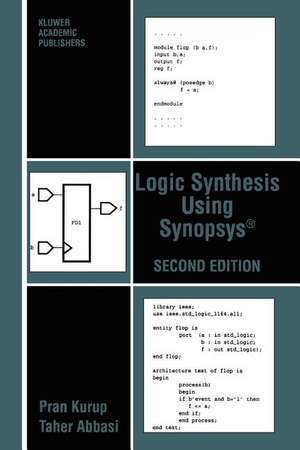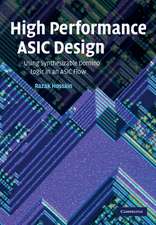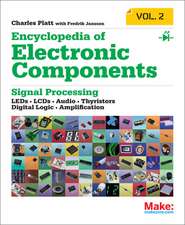Logic Synthesis Using Synopsys®
Autor Pran Kurup, Taher Abbasien Limba Engleză Paperback – 18 oct 2011
Logic Synthesis Using Synopsys®, Second Edition is an updated and revised version of the very successful first edition.
The second edition covers several new and emerging areas, in addition to improvements in the presentation and contents in all chapters from the first edition. With the rapid shrinking of process geometries it is becoming increasingly important that `physical' phenomenon like clusters and wire loads be considered during the synthesis phase. The increasing demand for FPGAs has warranted a greater focus on FPGA synthesis tools and methodology. Finally, behavioral synthesis, the move to designing at a higher level of abstraction than RTL, is fast becoming a reality. These factors have resulted in the inclusion of separate chapters in the second edition to cover Links to Layout, FPGA Synthesis and Behavioral Synthesis, respectively. Logic Synthesis Using Synopsys®, Second Edition has beenwritten with the CAD engineer in mind. A clear understanding of the synthesis tool concepts, its capabilities and the related CAD issues will help the CAD engineer formulate an effective synthesis-based ASIC design methodology. The intent is also to assist design teams to better incorporate and effectively integrate synthesis with their existing in-house design methodology and CAD tools.
| Toate formatele și edițiile | Preț | Express |
|---|---|---|
| Paperback (1) | 930.90 lei 6-8 săpt. | |
| Springer Us – 18 oct 2011 | 930.90 lei 6-8 săpt. | |
| Hardback (1) | 939.76 lei 6-8 săpt. | |
| Springer Us – 31 oct 1996 | 939.76 lei 6-8 săpt. |
Preț: 930.90 lei
Preț vechi: 1135.24 lei
-18% Nou
Puncte Express: 1396
Preț estimativ în valută:
178.15€ • 185.60$ • 148.12£
178.15€ • 185.60$ • 148.12£
Carte tipărită la comandă
Livrare economică 08-22 februarie 25
Preluare comenzi: 021 569.72.76
Specificații
ISBN-13: 9781461286349
ISBN-10: 1461286344
Pagini: 348
Ilustrații: XXII, 322 p.
Dimensiuni: 155 x 235 x 18 mm
Greutate: 0.49 kg
Ediția:2nd ed. 1997
Editura: Springer Us
Colecția Springer
Locul publicării:New York, NY, United States
ISBN-10: 1461286344
Pagini: 348
Ilustrații: XXII, 322 p.
Dimensiuni: 155 x 235 x 18 mm
Greutate: 0.49 kg
Ediția:2nd ed. 1997
Editura: Springer Us
Colecția Springer
Locul publicării:New York, NY, United States
Public țintă
ResearchCuprins
1 High-Level Design Methodology Overview.- 1.1 ASIC Design Flow Using Synthesis.- 1.2 Design Compiler Basics.- 1.3 Classic Scenarios.- 2 VHDL/Verilog Coding for Synthesis.- 2.1 General HDL Coding Issues.- 2.2 VHDL vs. Verilog: The Language Issue.- 2.3 Finite State Machines.- 2.4 HDL Coding Examples.- 2.5 Classic Scenarios 65.- 3 Pre and Post-Synthesis Simulation.- 3.1 RTL Simulation.- 3.2 File Text IO in VHDL Using the TEXTIO Package.- 3.3 VHDL Gate Level Simulation.- 3.4 Verilog Gate Level Simulation.- 3.5 Classic Scenarios.- 4 Constraining and Optimizing Designs – I.- 4.1 Synthesis Background.- 4.2 Clock Specification for Synthesis.- 4.3 Design Compiler Timing Reports.- 4.4 Commonly Used Design Compiler Commands.- 4.5 Strategies for Compiling Designs.- 4.6 Typical Scenarios When Optimizing Designs.- 4.7 Guidelines for Logic Synthesis.- 4.8 Classic Scenarios.- 5 Constraining and Optimizing Designs – II.- 5.1 Finite State Machine (FSM) Synthesis.- 5.2 Fixing Min Delay Violations.- 5.3 Technology Translation.- 5.4 Translating Designs with Black-Box Cells.- 5.5 Pad Synthesis.- 5.6 Classic Scenarios.- 6 Links to Layout.- 6.1 Motivation for Links to Layout.- 6.2 Floorplanning.- 6.3 Link to Layout Flow Using FloorPlan Manager.- 6.4 Basic Links to Layout Commands.- 6.5 Creating Wire Load Models After Back-Annotation.- 6.6 Re-Optimizing Designs After P&R.- 6.7 Classic Scenarios.- 7 FPGA Synthesis.- 7.1 FPGAs vs. ASICs.- 7.2 Xilinx 4000 Architecture.- 7.3 Synopsys Setup (.synopsys_dc.setup) For Xilinx.- 7.4 Synopsys FPGA Compiler Flow.- 8 Design for Testability.- 8.1 Introduction to Test Synthesis.- 8.2 Test Synthesis Using Test Compiler.- 8.3 Design-Specific Issues in Test Synthesis.- 8.4 Clock Skew.- 8.5 Test Compiler Default Test Protocol.- 8.6 Test Compiler Tips.- 8.7Examples Showing the Entire Test Synthesis Flow.- 8.8 Classic Scenarios.- 9 Interfacing Between CAD Tools.- 9.1 Electronic Data Interchange Format (EDIF).- 9.2 Forward and Back-annotation.- 9.3 Design Compiler Input/Output Formats.- 9.4 Classic Scenarios.- 10 Design Re-use Using Design Ware.- 10.1 DesignWare Libraries.- 10.2 Inferring Complex Cells.- 10.3 Creating Your Own Design Ware Library.- 10.4 Classic Scenarios.- 11 Behavioral Synthesis – An Introduction.- 11.1 Logic Synthesis.- 11.2 Behavioral Synthesis Concepts.- 11.3 Synopsys Behavioral Compiler.- 11.4 Behavioral Synthesis Design Flow.- 11.5 Example Using Behavioral Compiler.- 11.6 Behavioral Compiler Reports.- 11.7 Is Behavioral Synthesis Right For You?.- 11.8 Classic Scenarios.- Appendix A.- Sample dc_shell Scripts.- Sample Synopsys Technology Library.- Sample Synopsys Technology RAM Library Model.




















